Property Asset Management Report: Strategies for Singapore Buildings
VerifiedAdded on 2023/06/09
|13
|2196
|357
Report
AI Summary
This report addresses the issue of below-market-expectation occupancy rates in three commercial buildings managed by the client in Singapore. It employs both qualitative and quantitative research methodologies, including questionnaires and surveys, to gather data from tenants and the general public. A SWOT analysis identifies the strengths (location, elevator access), weaknesses (poor maintenance, noise, high rent), opportunities (redevelopment potential), and threats (new modern buildings). The report proposes improvements such as installing CCTV cameras, soundproofing, reviewing rent rates, repainting the building exterior, and installing dust-proof air conditioners. The conclusion emphasizes the need for implementing these recommendations to enhance the building's attractiveness and improve its occupancy rate, acknowledging that a full refurbishment may not be feasible. The report also includes appendices with a letter of introduction and the questionnaire used for data collection. Desklib provides this and other solved assignments to aid students in their studies.

Running header
Name:
Institution:
Title:
Name:
Institution:
Title:
Paraphrase This Document
Need a fresh take? Get an instant paraphrase of this document with our AI Paraphraser
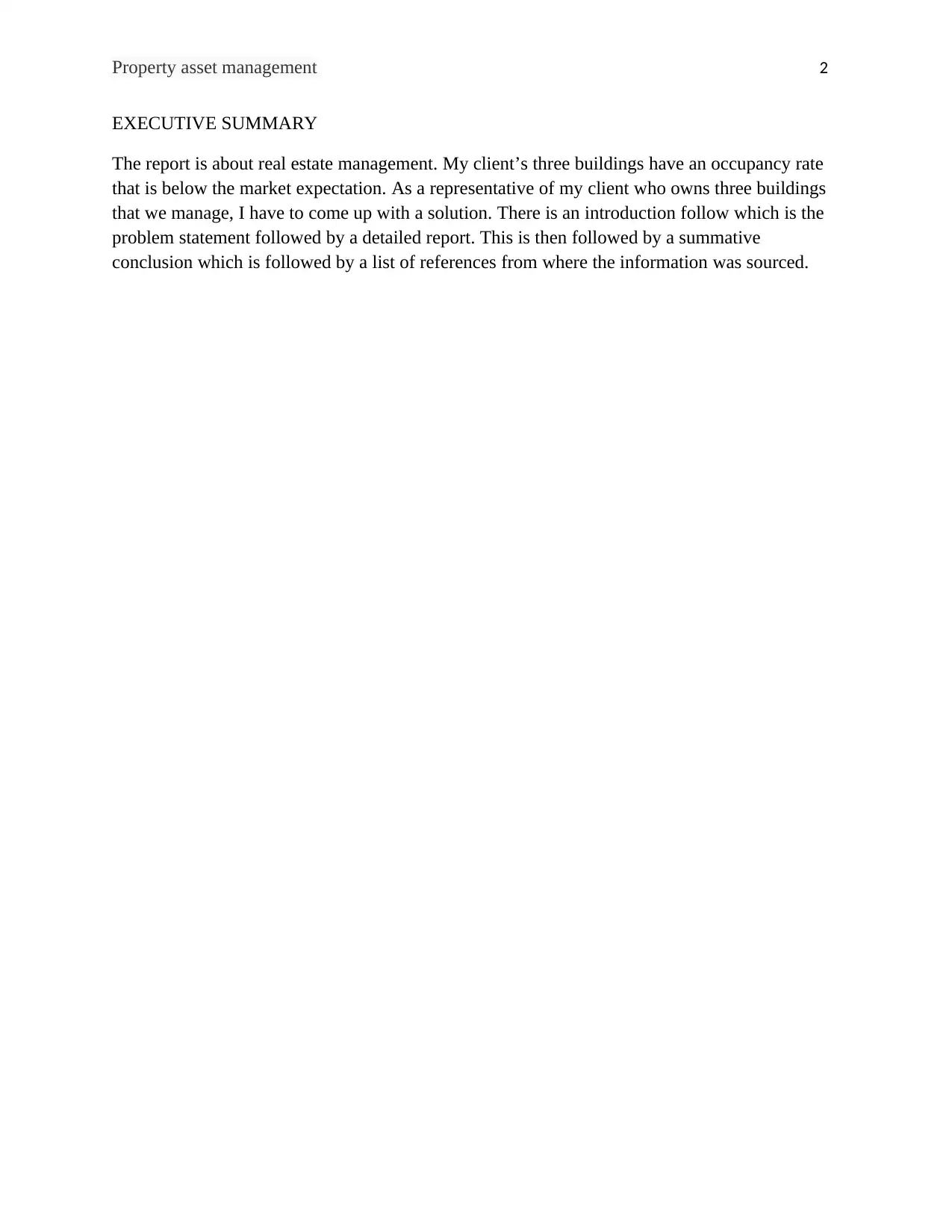
Property asset management 2
EXECUTIVE SUMMARY
The report is about real estate management. My client’s three buildings have an occupancy rate
that is below the market expectation. As a representative of my client who owns three buildings
that we manage, I have to come up with a solution. There is an introduction follow which is the
problem statement followed by a detailed report. This is then followed by a summative
conclusion which is followed by a list of references from where the information was sourced.
EXECUTIVE SUMMARY
The report is about real estate management. My client’s three buildings have an occupancy rate
that is below the market expectation. As a representative of my client who owns three buildings
that we manage, I have to come up with a solution. There is an introduction follow which is the
problem statement followed by a detailed report. This is then followed by a summative
conclusion which is followed by a list of references from where the information was sourced.
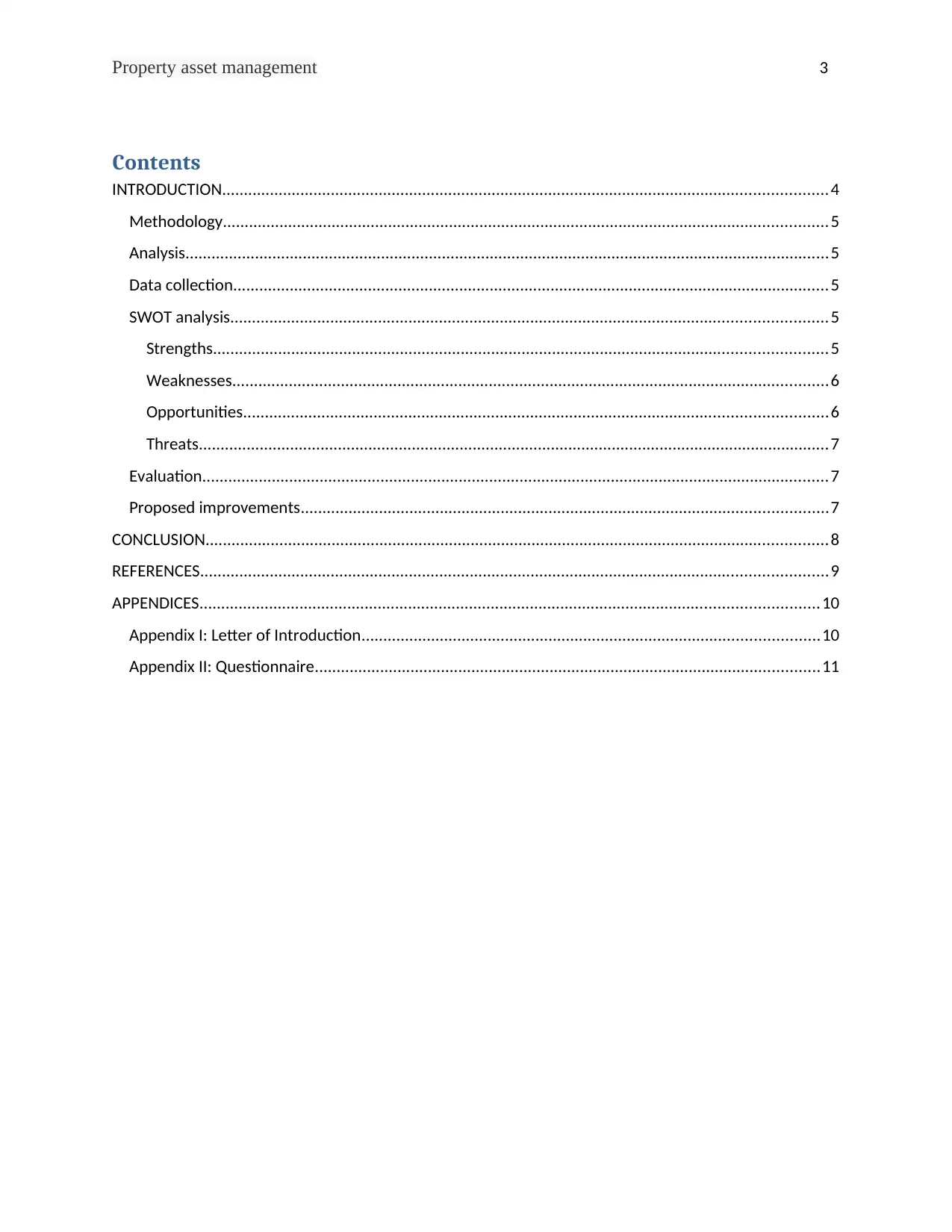
Property asset management 3
Contents
INTRODUCTION...........................................................................................................................................4
Methodology...........................................................................................................................................5
Analysis....................................................................................................................................................5
Data collection.........................................................................................................................................5
SWOT analysis.........................................................................................................................................5
Strengths.............................................................................................................................................5
Weaknesses.........................................................................................................................................6
Opportunities......................................................................................................................................6
Threats.................................................................................................................................................7
Evaluation................................................................................................................................................7
Proposed improvements.........................................................................................................................7
CONCLUSION...............................................................................................................................................8
REFERENCES................................................................................................................................................9
APPENDICES..............................................................................................................................................10
Appendix I: Letter of Introduction.........................................................................................................10
Appendix II: Questionnaire....................................................................................................................11
Contents
INTRODUCTION...........................................................................................................................................4
Methodology...........................................................................................................................................5
Analysis....................................................................................................................................................5
Data collection.........................................................................................................................................5
SWOT analysis.........................................................................................................................................5
Strengths.............................................................................................................................................5
Weaknesses.........................................................................................................................................6
Opportunities......................................................................................................................................6
Threats.................................................................................................................................................7
Evaluation................................................................................................................................................7
Proposed improvements.........................................................................................................................7
CONCLUSION...............................................................................................................................................8
REFERENCES................................................................................................................................................9
APPENDICES..............................................................................................................................................10
Appendix I: Letter of Introduction.........................................................................................................10
Appendix II: Questionnaire....................................................................................................................11
⊘ This is a preview!⊘
Do you want full access?
Subscribe today to unlock all pages.

Trusted by 1+ million students worldwide
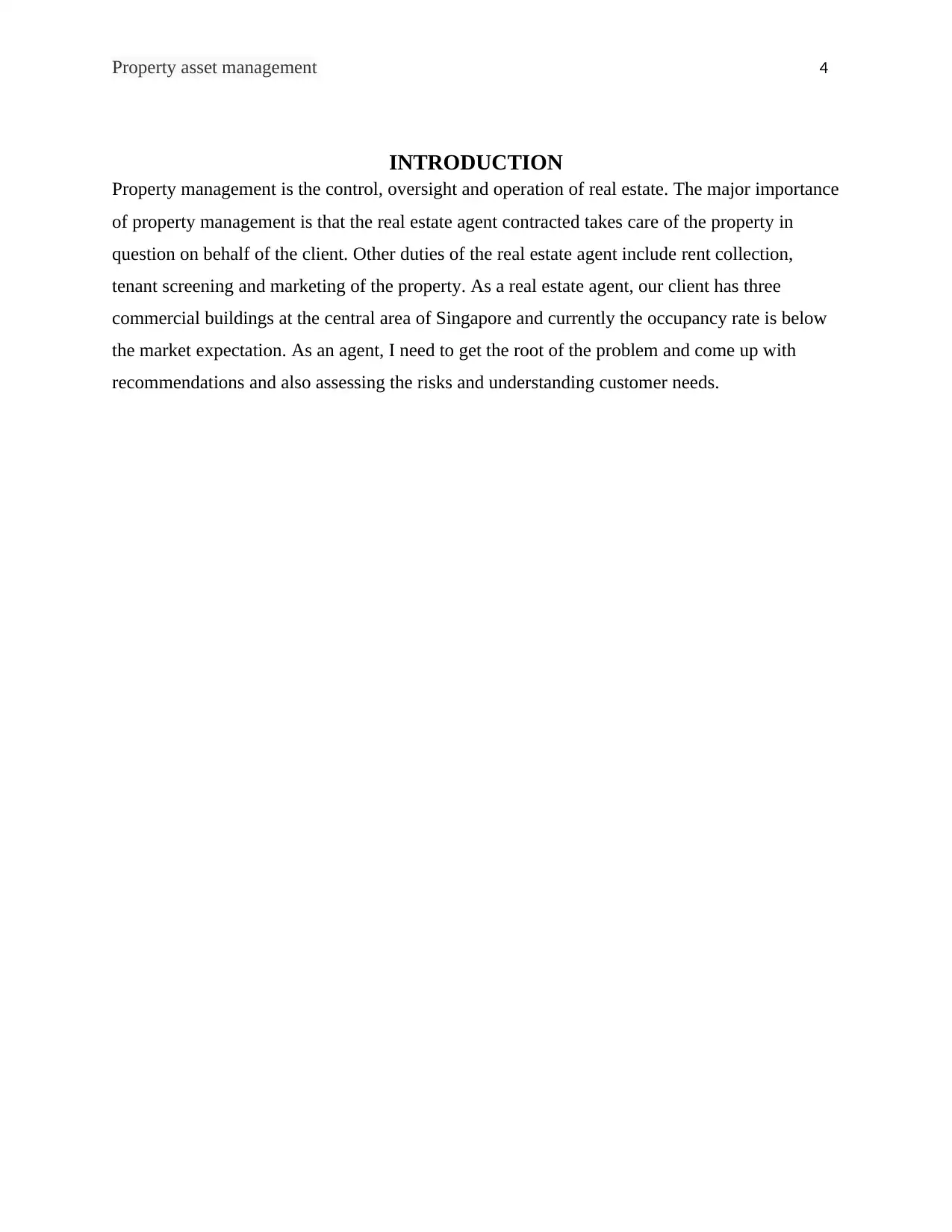
Property asset management 4
INTRODUCTION
Property management is the control, oversight and operation of real estate. The major importance
of property management is that the real estate agent contracted takes care of the property in
question on behalf of the client. Other duties of the real estate agent include rent collection,
tenant screening and marketing of the property. As a real estate agent, our client has three
commercial buildings at the central area of Singapore and currently the occupancy rate is below
the market expectation. As an agent, I need to get the root of the problem and come up with
recommendations and also assessing the risks and understanding customer needs.
INTRODUCTION
Property management is the control, oversight and operation of real estate. The major importance
of property management is that the real estate agent contracted takes care of the property in
question on behalf of the client. Other duties of the real estate agent include rent collection,
tenant screening and marketing of the property. As a real estate agent, our client has three
commercial buildings at the central area of Singapore and currently the occupancy rate is below
the market expectation. As an agent, I need to get the root of the problem and come up with
recommendations and also assessing the risks and understanding customer needs.
Paraphrase This Document
Need a fresh take? Get an instant paraphrase of this document with our AI Paraphraser
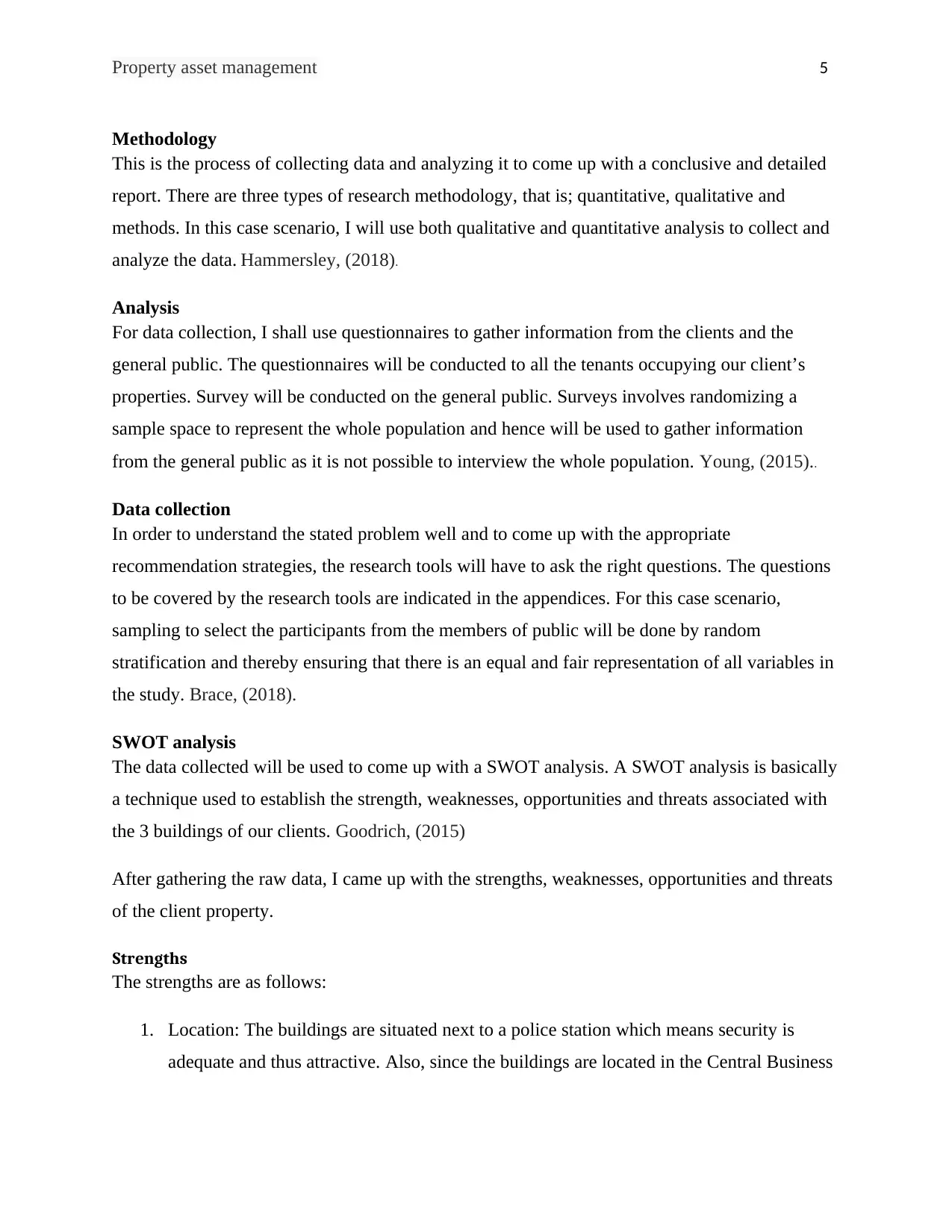
Property asset management 5
Methodology
This is the process of collecting data and analyzing it to come up with a conclusive and detailed
report. There are three types of research methodology, that is; quantitative, qualitative and
methods. In this case scenario, I will use both qualitative and quantitative analysis to collect and
analyze the data. Hammersley, (2018).
Analysis
For data collection, I shall use questionnaires to gather information from the clients and the
general public. The questionnaires will be conducted to all the tenants occupying our client’s
properties. Survey will be conducted on the general public. Surveys involves randomizing a
sample space to represent the whole population and hence will be used to gather information
from the general public as it is not possible to interview the whole population. Young, (2015)..
Data collection
In order to understand the stated problem well and to come up with the appropriate
recommendation strategies, the research tools will have to ask the right questions. The questions
to be covered by the research tools are indicated in the appendices. For this case scenario,
sampling to select the participants from the members of public will be done by random
stratification and thereby ensuring that there is an equal and fair representation of all variables in
the study. Brace, (2018).
SWOT analysis
The data collected will be used to come up with a SWOT analysis. A SWOT analysis is basically
a technique used to establish the strength, weaknesses, opportunities and threats associated with
the 3 buildings of our clients. Goodrich, (2015)
After gathering the raw data, I came up with the strengths, weaknesses, opportunities and threats
of the client property.
Strengths
The strengths are as follows:
1. Location: The buildings are situated next to a police station which means security is
adequate and thus attractive. Also, since the buildings are located in the Central Business
Methodology
This is the process of collecting data and analyzing it to come up with a conclusive and detailed
report. There are three types of research methodology, that is; quantitative, qualitative and
methods. In this case scenario, I will use both qualitative and quantitative analysis to collect and
analyze the data. Hammersley, (2018).
Analysis
For data collection, I shall use questionnaires to gather information from the clients and the
general public. The questionnaires will be conducted to all the tenants occupying our client’s
properties. Survey will be conducted on the general public. Surveys involves randomizing a
sample space to represent the whole population and hence will be used to gather information
from the general public as it is not possible to interview the whole population. Young, (2015)..
Data collection
In order to understand the stated problem well and to come up with the appropriate
recommendation strategies, the research tools will have to ask the right questions. The questions
to be covered by the research tools are indicated in the appendices. For this case scenario,
sampling to select the participants from the members of public will be done by random
stratification and thereby ensuring that there is an equal and fair representation of all variables in
the study. Brace, (2018).
SWOT analysis
The data collected will be used to come up with a SWOT analysis. A SWOT analysis is basically
a technique used to establish the strength, weaknesses, opportunities and threats associated with
the 3 buildings of our clients. Goodrich, (2015)
After gathering the raw data, I came up with the strengths, weaknesses, opportunities and threats
of the client property.
Strengths
The strengths are as follows:
1. Location: The buildings are situated next to a police station which means security is
adequate and thus attractive. Also, since the buildings are located in the Central Business
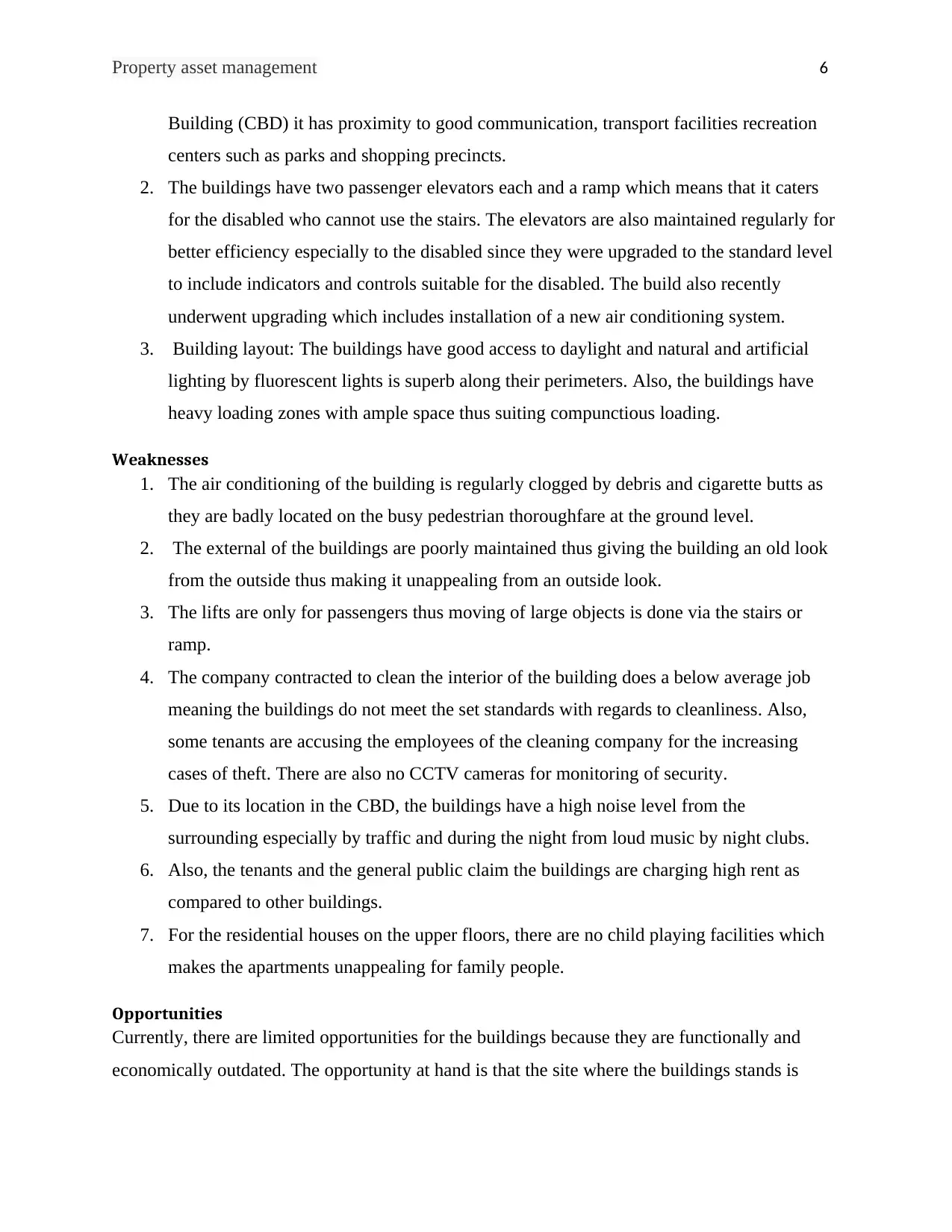
Property asset management 6
Building (CBD) it has proximity to good communication, transport facilities recreation
centers such as parks and shopping precincts.
2. The buildings have two passenger elevators each and a ramp which means that it caters
for the disabled who cannot use the stairs. The elevators are also maintained regularly for
better efficiency especially to the disabled since they were upgraded to the standard level
to include indicators and controls suitable for the disabled. The build also recently
underwent upgrading which includes installation of a new air conditioning system.
3. Building layout: The buildings have good access to daylight and natural and artificial
lighting by fluorescent lights is superb along their perimeters. Also, the buildings have
heavy loading zones with ample space thus suiting compunctious loading.
Weaknesses
1. The air conditioning of the building is regularly clogged by debris and cigarette butts as
they are badly located on the busy pedestrian thoroughfare at the ground level.
2. The external of the buildings are poorly maintained thus giving the building an old look
from the outside thus making it unappealing from an outside look.
3. The lifts are only for passengers thus moving of large objects is done via the stairs or
ramp.
4. The company contracted to clean the interior of the building does a below average job
meaning the buildings do not meet the set standards with regards to cleanliness. Also,
some tenants are accusing the employees of the cleaning company for the increasing
cases of theft. There are also no CCTV cameras for monitoring of security.
5. Due to its location in the CBD, the buildings have a high noise level from the
surrounding especially by traffic and during the night from loud music by night clubs.
6. Also, the tenants and the general public claim the buildings are charging high rent as
compared to other buildings.
7. For the residential houses on the upper floors, there are no child playing facilities which
makes the apartments unappealing for family people.
Opportunities
Currently, there are limited opportunities for the buildings because they are functionally and
economically outdated. The opportunity at hand is that the site where the buildings stands is
Building (CBD) it has proximity to good communication, transport facilities recreation
centers such as parks and shopping precincts.
2. The buildings have two passenger elevators each and a ramp which means that it caters
for the disabled who cannot use the stairs. The elevators are also maintained regularly for
better efficiency especially to the disabled since they were upgraded to the standard level
to include indicators and controls suitable for the disabled. The build also recently
underwent upgrading which includes installation of a new air conditioning system.
3. Building layout: The buildings have good access to daylight and natural and artificial
lighting by fluorescent lights is superb along their perimeters. Also, the buildings have
heavy loading zones with ample space thus suiting compunctious loading.
Weaknesses
1. The air conditioning of the building is regularly clogged by debris and cigarette butts as
they are badly located on the busy pedestrian thoroughfare at the ground level.
2. The external of the buildings are poorly maintained thus giving the building an old look
from the outside thus making it unappealing from an outside look.
3. The lifts are only for passengers thus moving of large objects is done via the stairs or
ramp.
4. The company contracted to clean the interior of the building does a below average job
meaning the buildings do not meet the set standards with regards to cleanliness. Also,
some tenants are accusing the employees of the cleaning company for the increasing
cases of theft. There are also no CCTV cameras for monitoring of security.
5. Due to its location in the CBD, the buildings have a high noise level from the
surrounding especially by traffic and during the night from loud music by night clubs.
6. Also, the tenants and the general public claim the buildings are charging high rent as
compared to other buildings.
7. For the residential houses on the upper floors, there are no child playing facilities which
makes the apartments unappealing for family people.
Opportunities
Currently, there are limited opportunities for the buildings because they are functionally and
economically outdated. The opportunity at hand is that the site where the buildings stands is
⊘ This is a preview!⊘
Do you want full access?
Subscribe today to unlock all pages.

Trusted by 1+ million students worldwide
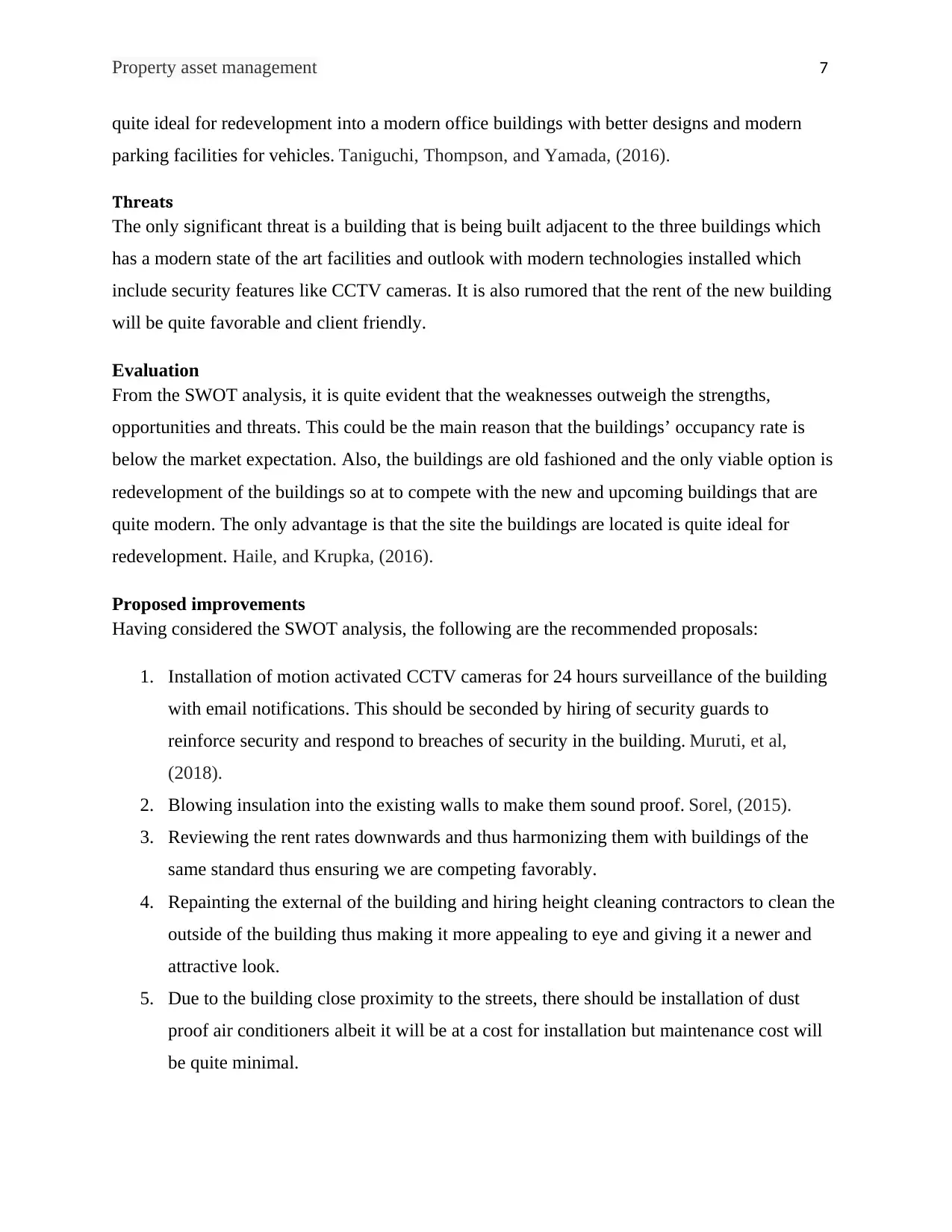
Property asset management 7
quite ideal for redevelopment into a modern office buildings with better designs and modern
parking facilities for vehicles. Taniguchi, Thompson, and Yamada, (2016).
Threats
The only significant threat is a building that is being built adjacent to the three buildings which
has a modern state of the art facilities and outlook with modern technologies installed which
include security features like CCTV cameras. It is also rumored that the rent of the new building
will be quite favorable and client friendly.
Evaluation
From the SWOT analysis, it is quite evident that the weaknesses outweigh the strengths,
opportunities and threats. This could be the main reason that the buildings’ occupancy rate is
below the market expectation. Also, the buildings are old fashioned and the only viable option is
redevelopment of the buildings so at to compete with the new and upcoming buildings that are
quite modern. The only advantage is that the site the buildings are located is quite ideal for
redevelopment. Haile, and Krupka, (2016).
Proposed improvements
Having considered the SWOT analysis, the following are the recommended proposals:
1. Installation of motion activated CCTV cameras for 24 hours surveillance of the building
with email notifications. This should be seconded by hiring of security guards to
reinforce security and respond to breaches of security in the building. Muruti, et al,
(2018).
2. Blowing insulation into the existing walls to make them sound proof. Sorel, (2015).
3. Reviewing the rent rates downwards and thus harmonizing them with buildings of the
same standard thus ensuring we are competing favorably.
4. Repainting the external of the building and hiring height cleaning contractors to clean the
outside of the building thus making it more appealing to eye and giving it a newer and
attractive look.
5. Due to the building close proximity to the streets, there should be installation of dust
proof air conditioners albeit it will be at a cost for installation but maintenance cost will
be quite minimal.
quite ideal for redevelopment into a modern office buildings with better designs and modern
parking facilities for vehicles. Taniguchi, Thompson, and Yamada, (2016).
Threats
The only significant threat is a building that is being built adjacent to the three buildings which
has a modern state of the art facilities and outlook with modern technologies installed which
include security features like CCTV cameras. It is also rumored that the rent of the new building
will be quite favorable and client friendly.
Evaluation
From the SWOT analysis, it is quite evident that the weaknesses outweigh the strengths,
opportunities and threats. This could be the main reason that the buildings’ occupancy rate is
below the market expectation. Also, the buildings are old fashioned and the only viable option is
redevelopment of the buildings so at to compete with the new and upcoming buildings that are
quite modern. The only advantage is that the site the buildings are located is quite ideal for
redevelopment. Haile, and Krupka, (2016).
Proposed improvements
Having considered the SWOT analysis, the following are the recommended proposals:
1. Installation of motion activated CCTV cameras for 24 hours surveillance of the building
with email notifications. This should be seconded by hiring of security guards to
reinforce security and respond to breaches of security in the building. Muruti, et al,
(2018).
2. Blowing insulation into the existing walls to make them sound proof. Sorel, (2015).
3. Reviewing the rent rates downwards and thus harmonizing them with buildings of the
same standard thus ensuring we are competing favorably.
4. Repainting the external of the building and hiring height cleaning contractors to clean the
outside of the building thus making it more appealing to eye and giving it a newer and
attractive look.
5. Due to the building close proximity to the streets, there should be installation of dust
proof air conditioners albeit it will be at a cost for installation but maintenance cost will
be quite minimal.
Paraphrase This Document
Need a fresh take? Get an instant paraphrase of this document with our AI Paraphraser
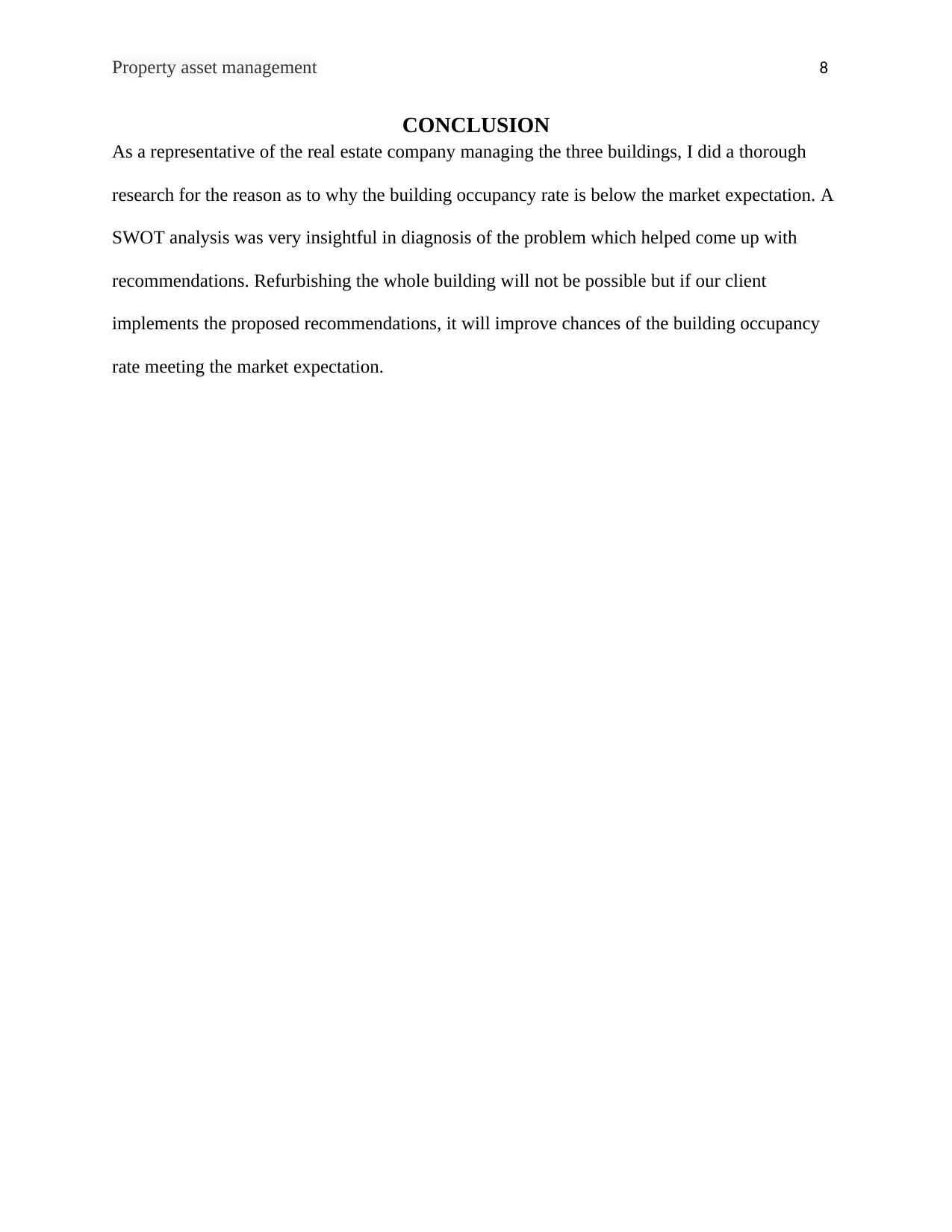
Property asset management 8
CONCLUSION
As a representative of the real estate company managing the three buildings, I did a thorough
research for the reason as to why the building occupancy rate is below the market expectation. A
SWOT analysis was very insightful in diagnosis of the problem which helped come up with
recommendations. Refurbishing the whole building will not be possible but if our client
implements the proposed recommendations, it will improve chances of the building occupancy
rate meeting the market expectation.
CONCLUSION
As a representative of the real estate company managing the three buildings, I did a thorough
research for the reason as to why the building occupancy rate is below the market expectation. A
SWOT analysis was very insightful in diagnosis of the problem which helped come up with
recommendations. Refurbishing the whole building will not be possible but if our client
implements the proposed recommendations, it will improve chances of the building occupancy
rate meeting the market expectation.
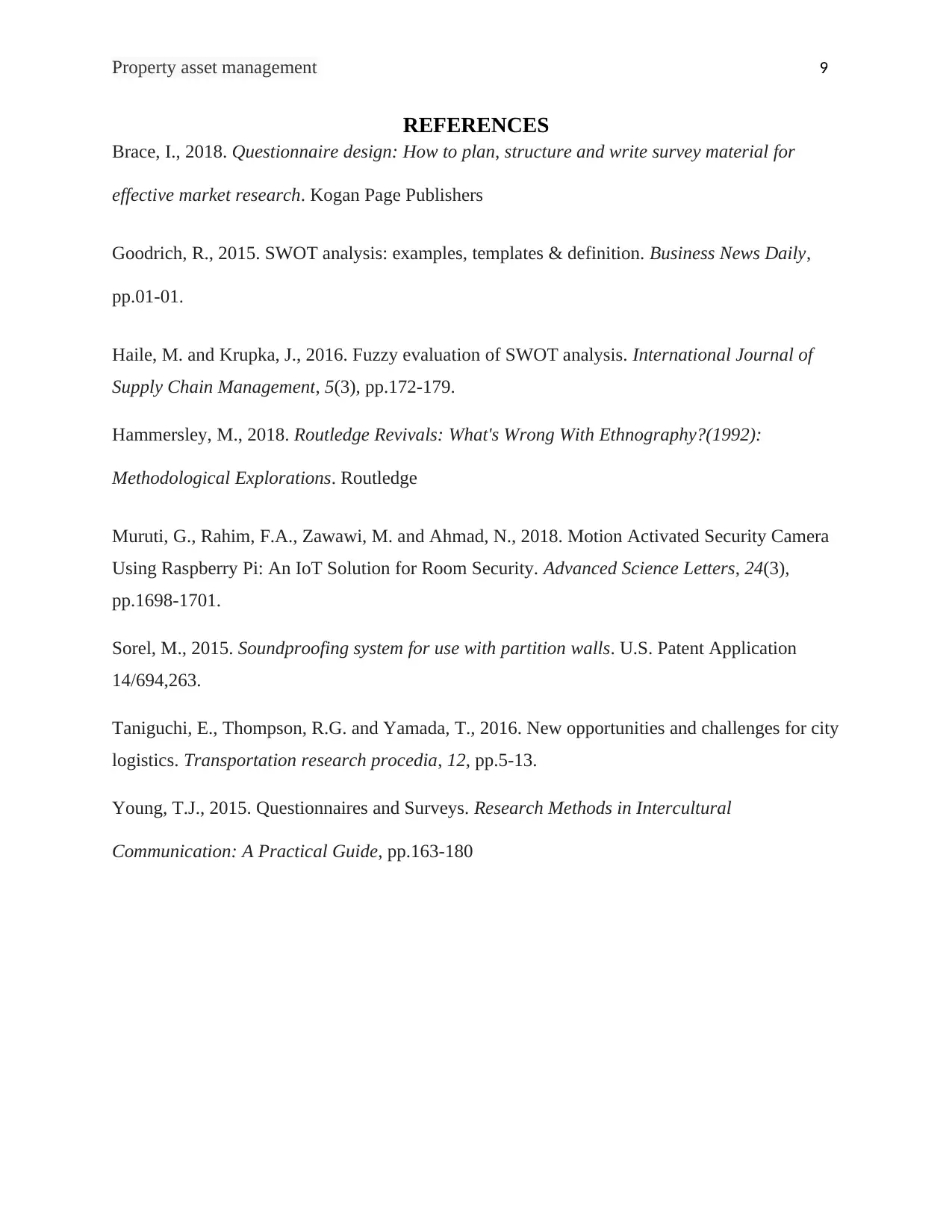
Property asset management 9
REFERENCES
Brace, I., 2018. Questionnaire design: How to plan, structure and write survey material for
effective market research. Kogan Page Publishers
Goodrich, R., 2015. SWOT analysis: examples, templates & definition. Business News Daily,
pp.01-01.
Haile, M. and Krupka, J., 2016. Fuzzy evaluation of SWOT analysis. International Journal of
Supply Chain Management, 5(3), pp.172-179.
Hammersley, M., 2018. Routledge Revivals: What's Wrong With Ethnography?(1992):
Methodological Explorations. Routledge
Muruti, G., Rahim, F.A., Zawawi, M. and Ahmad, N., 2018. Motion Activated Security Camera
Using Raspberry Pi: An IoT Solution for Room Security. Advanced Science Letters, 24(3),
pp.1698-1701.
Sorel, M., 2015. Soundproofing system for use with partition walls. U.S. Patent Application
14/694,263.
Taniguchi, E., Thompson, R.G. and Yamada, T., 2016. New opportunities and challenges for city
logistics. Transportation research procedia, 12, pp.5-13.
Young, T.J., 2015. Questionnaires and Surveys. Research Methods in Intercultural
Communication: A Practical Guide, pp.163-180
REFERENCES
Brace, I., 2018. Questionnaire design: How to plan, structure and write survey material for
effective market research. Kogan Page Publishers
Goodrich, R., 2015. SWOT analysis: examples, templates & definition. Business News Daily,
pp.01-01.
Haile, M. and Krupka, J., 2016. Fuzzy evaluation of SWOT analysis. International Journal of
Supply Chain Management, 5(3), pp.172-179.
Hammersley, M., 2018. Routledge Revivals: What's Wrong With Ethnography?(1992):
Methodological Explorations. Routledge
Muruti, G., Rahim, F.A., Zawawi, M. and Ahmad, N., 2018. Motion Activated Security Camera
Using Raspberry Pi: An IoT Solution for Room Security. Advanced Science Letters, 24(3),
pp.1698-1701.
Sorel, M., 2015. Soundproofing system for use with partition walls. U.S. Patent Application
14/694,263.
Taniguchi, E., Thompson, R.G. and Yamada, T., 2016. New opportunities and challenges for city
logistics. Transportation research procedia, 12, pp.5-13.
Young, T.J., 2015. Questionnaires and Surveys. Research Methods in Intercultural
Communication: A Practical Guide, pp.163-180
⊘ This is a preview!⊘
Do you want full access?
Subscribe today to unlock all pages.

Trusted by 1+ million students worldwide
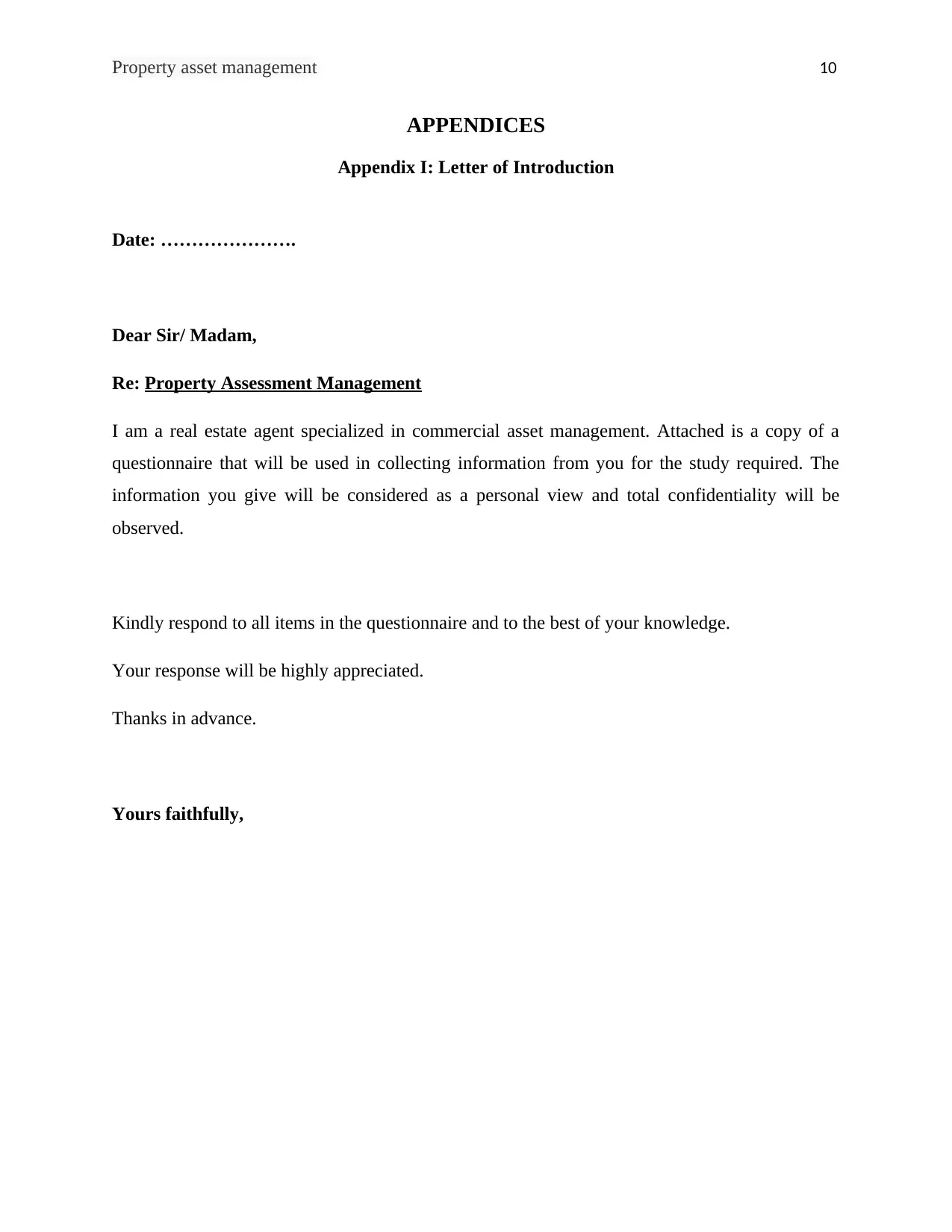
Property asset management 10
APPENDICES
Appendix I: Letter of Introduction
Date: ………………….
Dear Sir/ Madam,
Re: Property Assessment Management
I am a real estate agent specialized in commercial asset management. Attached is a copy of a
questionnaire that will be used in collecting information from you for the study required. The
information you give will be considered as a personal view and total confidentiality will be
observed.
Kindly respond to all items in the questionnaire and to the best of your knowledge.
Your response will be highly appreciated.
Thanks in advance.
Yours faithfully,
APPENDICES
Appendix I: Letter of Introduction
Date: ………………….
Dear Sir/ Madam,
Re: Property Assessment Management
I am a real estate agent specialized in commercial asset management. Attached is a copy of a
questionnaire that will be used in collecting information from you for the study required. The
information you give will be considered as a personal view and total confidentiality will be
observed.
Kindly respond to all items in the questionnaire and to the best of your knowledge.
Your response will be highly appreciated.
Thanks in advance.
Yours faithfully,
Paraphrase This Document
Need a fresh take? Get an instant paraphrase of this document with our AI Paraphraser
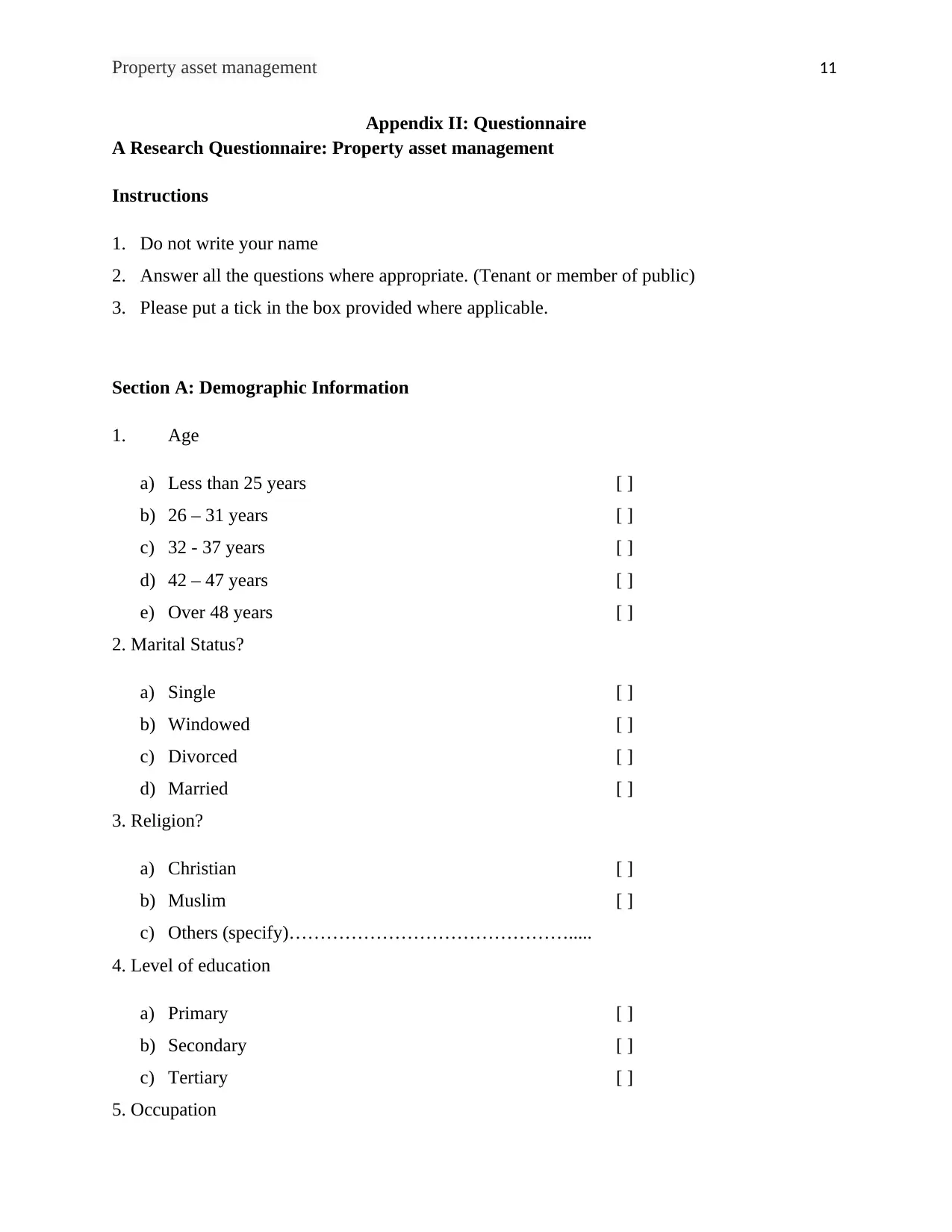
Property asset management 11
Appendix II: Questionnaire
A Research Questionnaire: Property asset management
Instructions
1. Do not write your name
2. Answer all the questions where appropriate. (Tenant or member of public)
3. Please put a tick in the box provided where applicable.
Section A: Demographic Information
1. Age
a) Less than 25 years [ ]
b) 26 – 31 years [ ]
c) 32 - 37 years [ ]
d) 42 – 47 years [ ]
e) Over 48 years [ ]
2. Marital Status?
a) Single [ ]
b) Windowed [ ]
c) Divorced [ ]
d) Married [ ]
3. Religion?
a) Christian [ ]
b) Muslim [ ]
c) Others (specify)……………………………………….....
4. Level of education
a) Primary [ ]
b) Secondary [ ]
c) Tertiary [ ]
5. Occupation
Appendix II: Questionnaire
A Research Questionnaire: Property asset management
Instructions
1. Do not write your name
2. Answer all the questions where appropriate. (Tenant or member of public)
3. Please put a tick in the box provided where applicable.
Section A: Demographic Information
1. Age
a) Less than 25 years [ ]
b) 26 – 31 years [ ]
c) 32 - 37 years [ ]
d) 42 – 47 years [ ]
e) Over 48 years [ ]
2. Marital Status?
a) Single [ ]
b) Windowed [ ]
c) Divorced [ ]
d) Married [ ]
3. Religion?
a) Christian [ ]
b) Muslim [ ]
c) Others (specify)……………………………………….....
4. Level of education
a) Primary [ ]
b) Secondary [ ]
c) Tertiary [ ]
5. Occupation
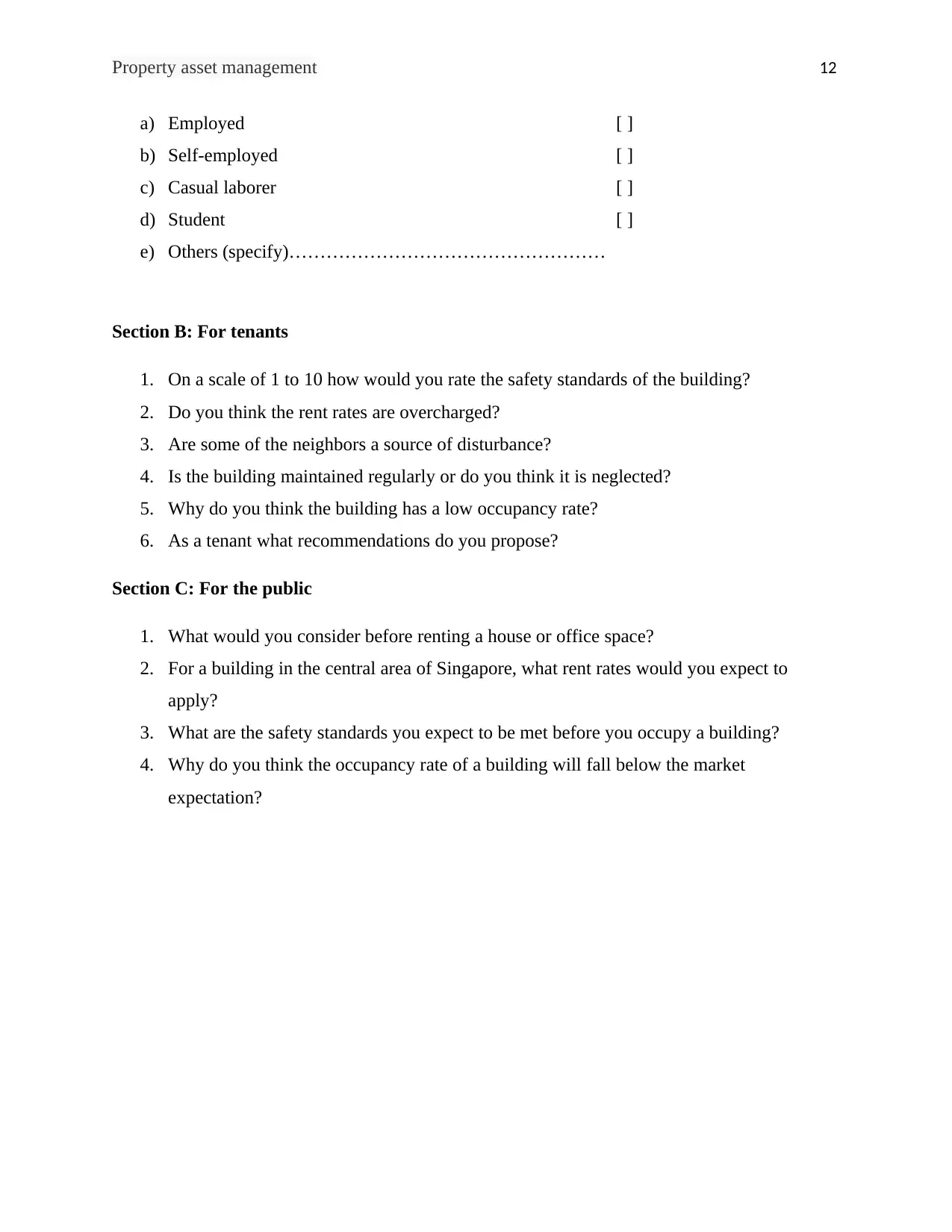
Property asset management 12
a) Employed [ ]
b) Self-employed [ ]
c) Casual laborer [ ]
d) Student [ ]
e) Others (specify)……………………………………………
Section B: For tenants
1. On a scale of 1 to 10 how would you rate the safety standards of the building?
2. Do you think the rent rates are overcharged?
3. Are some of the neighbors a source of disturbance?
4. Is the building maintained regularly or do you think it is neglected?
5. Why do you think the building has a low occupancy rate?
6. As a tenant what recommendations do you propose?
Section C: For the public
1. What would you consider before renting a house or office space?
2. For a building in the central area of Singapore, what rent rates would you expect to
apply?
3. What are the safety standards you expect to be met before you occupy a building?
4. Why do you think the occupancy rate of a building will fall below the market
expectation?
a) Employed [ ]
b) Self-employed [ ]
c) Casual laborer [ ]
d) Student [ ]
e) Others (specify)……………………………………………
Section B: For tenants
1. On a scale of 1 to 10 how would you rate the safety standards of the building?
2. Do you think the rent rates are overcharged?
3. Are some of the neighbors a source of disturbance?
4. Is the building maintained regularly or do you think it is neglected?
5. Why do you think the building has a low occupancy rate?
6. As a tenant what recommendations do you propose?
Section C: For the public
1. What would you consider before renting a house or office space?
2. For a building in the central area of Singapore, what rent rates would you expect to
apply?
3. What are the safety standards you expect to be met before you occupy a building?
4. Why do you think the occupancy rate of a building will fall below the market
expectation?
⊘ This is a preview!⊘
Do you want full access?
Subscribe today to unlock all pages.

Trusted by 1+ million students worldwide
1 out of 13
Related Documents
Your All-in-One AI-Powered Toolkit for Academic Success.
+13062052269
info@desklib.com
Available 24*7 on WhatsApp / Email
![[object Object]](/_next/static/media/star-bottom.7253800d.svg)
Unlock your academic potential
Copyright © 2020–2025 A2Z Services. All Rights Reserved. Developed and managed by ZUCOL.





